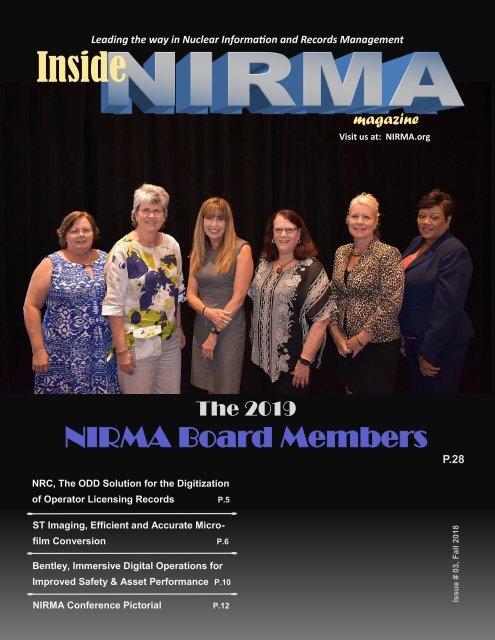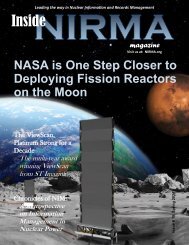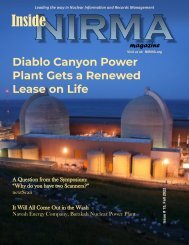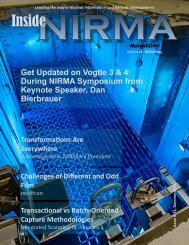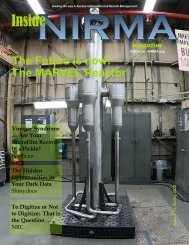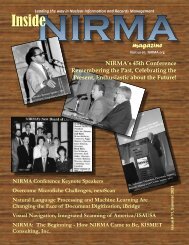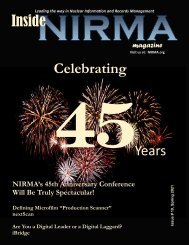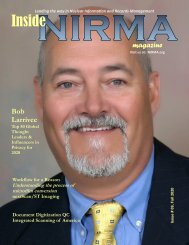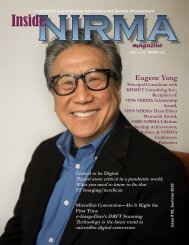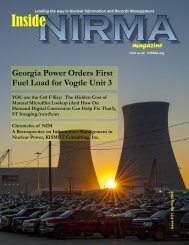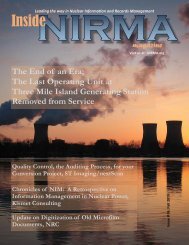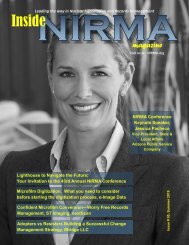Inside NIRMA Fall 2018 FINAL
You also want an ePaper? Increase the reach of your titles
YUMPU automatically turns print PDFs into web optimized ePapers that Google loves.
Issue # 03, <strong>Fall</strong> <strong>2018</strong><br />
Leading the way in Nuclear Information and Records Management<br />
<strong>Inside</strong><br />
magazine<br />
Visit us at: <strong>NIRMA</strong>.org<br />
The 2019<br />
<strong>NIRMA</strong> Board Members<br />
P.28<br />
NRC, The ODD Solution for the Digitization<br />
of Operator Licensing Records P.5<br />
ST Imaging, Efficient and Accurate Microfilm<br />
Conversion P.6<br />
Bentley, Immersive Digital Operations for<br />
Improved Safety & Asset Performance P.10<br />
<strong>NIRMA</strong> Conference Pictorial P.12
Contents<br />
Feature Articles<br />
5 The ODD Solution for the<br />
Digitization of Operator<br />
Licensing Records<br />
By Mackenzie Stevens, NRC<br />
6 Efficient and Accurate Microfilm<br />
Conversion<br />
By Matt Anderson, ST Imaging, nextScan<br />
8 Chronicles of NIM: A<br />
Retrospective on Information<br />
Management in Nuclear Power<br />
By Eugene Yang, Kismet Consulting<br />
10 Immersive Digital Operations<br />
for Improved Safety & Asset<br />
Performance<br />
By Leslie Robins & Sandra DiMatteo, Bentley<br />
12 <strong>NIRMA</strong> Conference Pictorial<br />
in every issue<br />
FROM YOUR PRESIDENT—22<br />
VICE PRESIDENTS REPORT—23<br />
MEET THE <strong>NIRMA</strong> BOARD—24<br />
SECRETARY NEWS—25<br />
RIMBU NEWS—26<br />
PDBU NEWS—27<br />
TREASURER’S REPORT—27<br />
M&MBU NEWS—28<br />
INDUSTRY NEWS—29<br />
NOMINATING COMMITTEE—30<br />
<strong>Inside</strong> <strong>NIRMA</strong> <strong>NIRMA</strong>.org <strong>Fall</strong> <strong>2018</strong> 3
Rich Giska and Sarah Perkins receiving recognition from <strong>NIRMA</strong> President,<br />
Michelle Smith for their support of the ANSI Audit Project.<br />
<strong>2018</strong> <strong>NIRMA</strong> Annual Conference Stats:<br />
<br />
<br />
<br />
<br />
23 First Time Attendees<br />
29 Educational Sessions<br />
5 Keynote Speakers<br />
14 Vendor Exhibits<br />
Stay Connected<br />
with <strong>NIRMA</strong>!<br />
<br />
<br />
<br />
<strong>NIRMA</strong> is now using Constant Contact for emails. Be<br />
sure to add nirmaorg10@gmail.com to your safe<br />
senders list.<br />
<strong>Inside</strong> <strong>NIRMA</strong>, our digital magazine, will be emailed to<br />
subscribers three times per year. This replaces our<br />
newsletter that was previously sent via U.S. Mail.<br />
We are now on Twitter. Please follow us @<strong>NIRMA</strong>org<br />
and if you haven’t already, like us on Facebook and<br />
connect with us on LinkedIn.<br />
We value your feedback. Share your thoughts with our<br />
Communication Team at DevereauxInc@outlook.com.<br />
Thanks for reading.<br />
Keep in touch!<br />
4 <strong>Fall</strong> <strong>2018</strong> <strong>NIRMA</strong>.org <strong>Inside</strong> <strong>NIRMA</strong>
n October 2015, the Nuclear Regulatory<br />
Commission’s Office of Nuclear Reactor<br />
Regulation (NRR) approached the Office of the<br />
Chief Information Officer (OCIO) for help<br />
building a system that would automate the operator<br />
licensing (OL) process. The OL process for new<br />
candidates can take two years or longer: the candidate<br />
must complete an accredited training program certified<br />
by the National Nuclear Accrediting Board and pass<br />
exams that are specific to the site(s) for which a<br />
candidate is seeking to be licensed to operate. As one<br />
can imagine, there is quite a bit of tracking and<br />
managing of the candidates throughout the process, and<br />
a lot of paperwork!<br />
The OL Assistants, who’ve been invaluable to the<br />
Operator Digitized Docket (ODD) project, are<br />
inundated with creating packages for management<br />
signature, then scanning and profiling these documents<br />
into the Agencywide Documents Access and<br />
Management System (ADAMS), as well as performing<br />
their other job duties. Based on a study conducted in<br />
2014, it was estimated that there were 385 new operator<br />
licenses issued across the agency, which accounted for<br />
approximately 1,540 files that were packaged, scanned,<br />
and profiled for more than 460 hours of work! That is a<br />
lot of paper and a lot of time! The new solution, ODD,<br />
delivers the secure, time and cost saving solution to the<br />
digitization endeavor! The system is basically a<br />
workflow of actions that comprise the OL process.<br />
The Electronic Information Exchange (EIE),<br />
which provides direct input to ODD, allows for the<br />
timely, secure, and cheap electronic delivery of OL<br />
documents to the agency and the transmittal of these<br />
documents back to the candidate or licensee. Without<br />
the interface to EIE, licensees would continue to mail<br />
THE ODD SOLUTION FOR<br />
THE DIGITIZATION OF<br />
OPERATOR LICENSING<br />
RECORDS<br />
By Mackenzie Stevens, NRC IT Specialist<br />
documents to the agency via the U.S. Postal Service.<br />
Because ODD and ADAMS are hosted on the<br />
same platform, after the OL documents are delivered<br />
electronically to the NRC, the documents are<br />
electronically profiled and added to ADAMS directly<br />
from the ODD system.<br />
ODD also interfaces with the Reactor Program<br />
System (RPS), which is the authoritative source for OL<br />
data. ODD uses a capture tool to extrapolate data from<br />
candidate licensing applications sent via EIE, and sends<br />
the data to RPS. Prior to this interface, the OL<br />
Assistants keyed in the data after receiving the hard<br />
copies from the licensees.<br />
One of coolest features of ODD is the ability to<br />
electronically sign OL documents. Exam graders and<br />
Branch Chiefs at the NRC electronically approve the<br />
various OL documents and, upon using the “Sign”<br />
function, an image of the signature is imprinted onto the<br />
document in the appropriate box. After approval, the<br />
documents are auto-profiled (with the exception of a<br />
few properties) and added into ADAMS without manual<br />
intervention. This is a tremendous time saving from<br />
having to populate each document property by hand<br />
after scanning the documents into ADAMS.<br />
The interfaces and features of ODD make the<br />
system an innovative solution for the digitization of OL<br />
records. At the time of this writing, ODD is completing<br />
pilots with all four NRC regional offices and can only be<br />
used to manage new operator licenses. However, once<br />
other licensing workflows are implemented in the<br />
system, it is projected to save the agency around<br />
$276K annually … and there’s nothing ODD about<br />
that!<br />
<strong>Inside</strong> <strong>NIRMA</strong> <strong>NIRMA</strong>.org <strong>Fall</strong> <strong>2018</strong> 5
EFFICIENT AND ACCURATE<br />
MICROFILM CONVERSION<br />
By Matt Anderson, Vice President of Marketing<br />
n previous issues of the <strong>NIRMA</strong> newsletter, we<br />
have covered best practices for microfilm<br />
conversion. Those topics have included speed,<br />
accuracy, image quality, as well as quality control.<br />
One topic overlooked is how effective the scanner is at<br />
detecting individual frames of data. Two common<br />
techniques<br />
available today are<br />
edge detection and<br />
complete ribbon<br />
scanning, one<br />
using last century’s<br />
technology and the<br />
other defining the<br />
way we capture<br />
microfilm in the<br />
digital age.<br />
Before deciding<br />
on which scanner<br />
is best for you, ask<br />
your vendor what<br />
type of frame<br />
detection their<br />
product supports.<br />
This is the most important element that affects capture<br />
accuracy and overall conversion efficiency.<br />
Most entry-level film and fiche scanners were<br />
originally designed for on-demand use. They employ<br />
what is commonly known in the industry as “edge<br />
detection.” This technology utilizes the camera and<br />
software to detect a gap between frames, indicating the<br />
end of one and the beginning of another. Unfortunately,<br />
there is no way to know if every image was captured or if<br />
any were missed without checking each frame<br />
individually.<br />
Ribbon scanning technology is a digital scanning<br />
technique applying a line scanning technology that<br />
captures all the data from an entire roll of microfilm,<br />
from top to bottom, beginning to end. The system does<br />
not rely on edge detection and does not miss a single<br />
frame. This technique guarantees everything on the roll<br />
was captured and allows for<br />
expedited quality control.<br />
Using perfect film, for example, in Exhibit A (which<br />
has the same size and orientation of images with perfect<br />
spacing and blips from beginning to end) reveals that<br />
there is a 90%<br />
chance you can<br />
get accurate<br />
results from any<br />
scanner using<br />
edge detection<br />
and you will likely<br />
have some<br />
rescans before<br />
you can fully<br />
digitize a roll.<br />
If your<br />
film is like<br />
Exhibit B and<br />
similar to most<br />
collections in the<br />
world (different<br />
size, different<br />
spacing, skew, light, dark, etc.), there is 0% you can get<br />
accurate results from any scanner using edge detection,<br />
and you will likely have many rescans before you fully<br />
digitize a roll.<br />
All nextScan scanners, including FlexView, apply the<br />
ribbon scanning technique. The task of conversion is too<br />
important to rely on edge detection. Regardless if your<br />
film looks like A or B, the only way to guarantee 100%<br />
reliable and accurate captures every time is by using<br />
ribbon scanning technology, creating a full digital<br />
duplicate of each roll.<br />
We want you to have an easy and successful<br />
conversion. Get your conversion project started<br />
correctly by requesting a demo or have sample scans<br />
created with your film so you know what to expect. Do<br />
not forget to ask your vendor if their scanner supports<br />
21st Century ribbon scanning or still uses 20th Century<br />
edge detection.<br />
6 <strong>Fall</strong> <strong>2018</strong> <strong>NIRMA</strong>.org <strong>Inside</strong> <strong>NIRMA</strong>
FLEXVIEW<br />
MICROFILM SCANNER<br />
IN-HOUSE, COST EFFECTIVE AND PROFESSIONAL<br />
MICROFILM CONVERSION<br />
The new FlexView, though small in size, is mighty<br />
when it comes to converting rolls of microfilm.<br />
With dimensions that allow for the scanner to be<br />
placed on a desktop, the FlexView delivers the<br />
high-quality images you have grown to expect<br />
from the nextScan family of scanners. It’s fast<br />
too! Able to scan at up to 300 FPM, the FlexView<br />
is the professional, portable microfilm conversion<br />
scanner you have been waiting for!<br />
Visit www.nextScan.com for more details and to download a brochure.<br />
Call 208-514-4000 or email sales@nextScan.com for more information.<br />
Capable of scanning: 16mm, 35mm and Blipped Film<br />
NextStar PLUS Software<br />
FlexView operates with NextStar PLUS Software<br />
providing optimum speed and functionality<br />
reducing overall conversion costs
A Retrospective on Information<br />
Management in Nuclear Power<br />
By Eugene Y. Yang, Principal Consultant,<br />
KISMET Consulting, Inc.<br />
One of the frequent questions I get is, “how did all of this<br />
electronic records stuff get started?” I have been fortunate to<br />
have implemented or consulted through the “golden age” of<br />
managing electronic records. I’m usually somewhat conflicted<br />
in describing this sea change in the nuclear power industry –<br />
was it either an evolution...or a revolution? So, I’ll answer<br />
this question in a two-part series.<br />
Part 1: Moving to a Revolution?<br />
The Basis<br />
Of course, you need to go back to the regulatory<br />
foundation. As the civilian use of nuclear material and<br />
technology is controlled and regulated, the United States<br />
Nuclear Regulatory Commission (NRC) requires a<br />
quality assurance program. Such a program is necessary<br />
to provide reasonable assurance of adequate protection<br />
of public health and safety and to protect the<br />
environment. The requirements for records<br />
management appear in 10 CFR 50, Appendix B,<br />
“Quality Assurance Criteria for Nuclear Power Plants<br />
and Fuel Reprocessing Plants,” under Criterion 17,<br />
“Quality Assurance Records.”<br />
The Response<br />
Through guidance from the NRC (Regulatory Guides<br />
1.28, 1.88), the nuclear power industry developed<br />
standards for implementation of a QA program: ASME<br />
Nuclear Quality Assurance, ASME NQA-1, “Quality<br />
Assurance Requirements for Nuclear Facility<br />
Applications” or the ANSI N45.2, “Quality Assurance<br />
Program Requirements for Nuclear Facilities.” With<br />
Appendix B, and these standards, the nuclear industry<br />
was compelled to develop and maintain a rigorous<br />
program for managing quality assurance records.<br />
The Result<br />
Paper, lots of paper. Overflowing. “Raiders of the Lost<br />
Ark” rows of file cabinet after file cabinet. Paper boxes<br />
piling up – and this was just in the vaults! Then there<br />
were the record copies in satellite locations, information<br />
needed (as part of a controlled documents program) by<br />
the various departments. And not just the 8 ½ x 11<br />
variety (A-size), but the other alphabet soup of paper<br />
sizes (B, C, D, E, F…).<br />
The Solution<br />
Solution 1: Better paper storage.<br />
Cubic stacking of boxes, mobile<br />
shelving, bigger file cabinets, the use<br />
of offsite storage. More file cabinets<br />
in the various departments.<br />
However, this approach was soon<br />
defeated by the continuing waves of<br />
paper.<br />
8 <strong>Fall</strong> <strong>2018</strong> <strong>NIRMA</strong>.org <strong>Inside</strong> <strong>NIRMA</strong>
Solution 2: Microfilm! The business use of microfilm<br />
didn’t really gain traction until World War II, as the<br />
military used it for espionage as well as for “normal”<br />
applications. Then, between the banking industry and<br />
the libraries, microfilm really took off and eventually<br />
found another home in the nuclear power industry.<br />
<strong>NIRMA</strong>, in the early 80’s, was on the forefront in the<br />
implementation and use of various microfilm formats,<br />
documented through its technical guidelines (e.g., 35<br />
mm, 16 mm, aperture cards). Mainframe computers<br />
emerged to offer capturing of records indexing<br />
(metadata) information, and then providing online<br />
search and lookup. By the mid-80’s, a hybrid appeared<br />
called “computer automated retrieval”, where a search<br />
would be performed using a mainframe terminal, and<br />
then when the appropriate document was selected, it<br />
would communicate with a microfilm reader to scroll to<br />
the appropriate frame number. (Woohoo!)<br />
South Texas Project initiated this request to the NRC: if<br />
the technology exists to scan a record, store it in a way<br />
to protect its integrity, and then retrieve it via a<br />
computer screen, why not make the electronic version<br />
THE record? In 1988, the NRC issued Generic Letter<br />
88-18, “Plant Record Storage on Optical Disks,” which<br />
allowed quality assurance records to be stored in the<br />
electronic optical disk medium. Several electric utilities/<br />
plants soon jumped on this technology. If a plant could<br />
demonstrate that its implementation of electronic<br />
records was compliant to the eight quality controls listed<br />
in the generic letter, the NRC allowed this method for<br />
managing QA records.<br />
But is this where the story ends? Was optical disk the<br />
only way to go? What if a plant couldn’t cost-justify<br />
such a system, but wanted to move to electronic<br />
recordkeeping? Stay tuned, same NIM column, different<br />
Magazine issue!<br />
Eugene has been a member of <strong>NIRMA</strong> for over 32 years. At<br />
the time he joined, <strong>NIRMA</strong> had only been in existence for 11<br />
years. He would love to hear about stories and anecdotes from<br />
others, so please email him at:<br />
eugene.yang@kismetconsulting.com.<br />
Solution 3: Electronic indexing AND storage of<br />
records. As new plants were being built and looking<br />
to go operational in the latter part of the 80’s, there<br />
arose an opportunity to challenge the notion of<br />
“keeping paper” or film as the official record medium.<br />
<strong>Inside</strong> <strong>NIRMA</strong> <strong>NIRMA</strong>.org <strong>Fall</strong> <strong>2018</strong> 9
IMMERSIVE DIGITAL OPERATIONS<br />
FOR IMPROVED SAFETY AND ASSET<br />
PERFORMANCE<br />
By Leslie Robins, Asset Performance Consultant &<br />
Sandra DiMatteo, Director Asset Performance<br />
Leslie Robins<br />
he nuclear industry is asset-intensive, and with<br />
the inherent safety concerns of working in<br />
hazardous areas of plants it’s especially useful to<br />
be able to “see” what’s going on without gearing up and<br />
sending workers to physically inspect some assets unless<br />
it is necessary. In addition, most people are visual<br />
learners, absorbing and understanding information<br />
better when information is presented graphically rather<br />
than in text. Visualizing the plant enables an intuitive<br />
approach to asset and operational performance that data<br />
and documents alone can’t provide.<br />
A virtual view of your assets<br />
Immersive digital operations technology allows you to<br />
work within a 3D or reality model of your nuclear<br />
Sandra DiMatteo<br />
facility. Visually display the facility and click on an asset<br />
to display asset, structures, system, component data, the<br />
reliability program, plus associated documents, records,<br />
requirements, people, and processes linked to the asset.<br />
Immersive digital operations enables you to establish<br />
line of sight, so you can navigate through the facility,<br />
observing equipment and structures, and access the<br />
information you need for operations.<br />
For example, you can examine a component to<br />
determine whether it should be repaired or replaced<br />
during a refueling outage. By simply clicking on that<br />
asset in your model, current information related to it like<br />
design basis requirements, schematics, manuals, piping<br />
and instrumentation diagrams (P&IDs), and other<br />
10 <strong>Fall</strong> <strong>2018</strong> <strong>NIRMA</strong>.org <strong>Inside</strong> <strong>NIRMA</strong>
associated documents can be displayed. The model can<br />
also be queried to display underlying data including GIS<br />
geolocations, elevation, current asset condition and<br />
operating context, configuration state, maintenance<br />
history, and reliability data.<br />
Immersive digital operations adds value when planning<br />
brownfield modifications and decommissioning.<br />
Planned assets can be added to the system and evaluated<br />
to determine impact of change, compliance with design<br />
basis requirements, and clash detection. Complimentary<br />
operational analytics technology provides configurable<br />
dashboards and reports, presenting trend analysis and<br />
KPIs for operational decision support, which can be run<br />
to optimize equipment and operational specifications.<br />
Simultaneously,<br />
decommissioning is an integral<br />
part of the lifecycle. Assets,<br />
records, requirements and other<br />
information objects can be<br />
flagged for advance planning<br />
activities, and to outline the<br />
steps for dismantling and remediation.<br />
Start anywhere, anytime<br />
Benefits can be derived at any point in your facility’s<br />
lifecycle.<br />
Step 1: Model your facility or network<br />
If you don’t have current digital models, there are many<br />
solutions available to create them. 2D imagery, point<br />
clouds, and reality mesh can be aligned in a 3D georeferenced<br />
space to create 3D models. The same<br />
technology may be used to update existing models to<br />
ensure the current state is represented and for<br />
comparison to previous states.<br />
Step 2: Leverage your common data<br />
environment (CDE)<br />
It is critical that all relevant information be accessible<br />
across operational disciplines. This requires a common<br />
data environment that allows you to collect, manage,<br />
and share information. Interoperable solutions, rather<br />
than proprietary closed systems, are critical to gaining<br />
timely access to data from information technology (IT),<br />
operational technology (OT), and engineering systems<br />
(ET). Correct decisions can only be made when you<br />
have the right data, information, and insights.<br />
Make informed decisions that<br />
improve asset and operational<br />
performance, safety, security,<br />
and compliance.<br />
Step 3: Identify and validate the accuracy of<br />
relevant asset information<br />
Ideally, your asset information system captured design<br />
data, and was managed with configuration management<br />
best practices through project delivery and asset<br />
commissioning for operational readiness and continues<br />
to be the single source of truth for asset information in<br />
operations. If validation occurs during operations, use a<br />
system that can track asset changes and configuration<br />
for best return on investment.<br />
Step 4: Select the right immersive digital operations<br />
solution<br />
A robust digital operations solution will either<br />
incorporate or access an asset<br />
lifecycle information<br />
management solution (including<br />
change and configuration<br />
management), and capabilities<br />
for operational analytics and<br />
asset reliability, such as drilling<br />
down to failure modes to know<br />
why you are doing the work you are doing. Holistically,<br />
these capabilities will deliver a complete view of asset<br />
information and digital line of sight to help manage and<br />
improve asset and operational performance. Attract the<br />
next generation of engineering professionals using<br />
technology that accesses digital models visually and<br />
positions you to improve decision support, productivity,<br />
reliability, and efficiency.<br />
Step 5: Optimize operational processes<br />
Once your digital operations solution is deployed,<br />
leverage the visibility of asset condition (for example,<br />
flashing alarms on a 3D model or map that links to 3D<br />
model). Access underlying data including the<br />
maintenance history, geospatial coordinates, condition<br />
degradation trends, and forecasted end of life. Make<br />
informed decisions that improve asset and operational<br />
performance, safety, security, and compliance.<br />
Bentley’s AssetWise includes immersive digital operations capabilities<br />
that help you optimize asset performance and support an asset strategy of<br />
regulatory compliance, operational efficiency, and risk mitigation. Built<br />
on a hybrid cloud-computing platform that leverages a common data<br />
environment, AssetWise facilitates the interoperation of multiple data<br />
sources, providing operations, maintenance, and engineering with accurate<br />
and reliable information, when it is needed, to make informed decisions,<br />
from capital planning through proactive asset maintenance.<br />
For additional information about AssetWise, visit:<br />
www.bentley.com/AssetWise<br />
<strong>Inside</strong> <strong>NIRMA</strong> <strong>NIRMA</strong>.org <strong>Fall</strong> <strong>2018</strong> 11
Six of the 23 1st Time Attendees at the New Attendee Orientation<br />
“The exhibits were a great<br />
opportunity for vendors to<br />
showcase their products and<br />
services and get to know more<br />
about how they help the<br />
nuclear industry become more<br />
lean and efficient.”<br />
Kyle Nase<br />
Software Engineering Supervisor<br />
Rolls-Royce plc<br />
“I appreciated all the information I received<br />
on basics like retention, organization,<br />
software but most importantly, advice from<br />
seasoned RMs who encouraged starting RM<br />
practices ASAP, as many plants are having<br />
issues with paper/records/files from more<br />
than a decade ago.”<br />
Celeste Mieles<br />
Operations Coordinator<br />
Kairos Power<br />
“The speakers covered a wide range<br />
of topics and it was nice that it<br />
wasn’t all specific to nuclear<br />
industry and included DOE, Canada,<br />
Japan, etc. It helps to see that the<br />
issues are present across the board<br />
and everyone is working on creative<br />
solutions .”<br />
Adrienne Hall<br />
Sr. Records Administrator<br />
Lawrence Livermore National Laboratory<br />
“I found the networking<br />
sessions to be very<br />
valuable. I also<br />
benefitted from the<br />
demonstrations of new<br />
technology and software<br />
from some of the<br />
vendors.”<br />
Amanda Haug<br />
Document Control Analyst<br />
DTE Energy – Fermi 2<br />
1st Time Attendee Presenters: Rebecca Wessman and Eugene Yang<br />
12 <strong>Fall</strong> <strong>2018</strong> <strong>NIRMA</strong>.org <strong>Inside</strong> <strong>NIRMA</strong>
Modern Records Management Specialist<br />
Jesse Wilkins, AIIM<br />
Managing Electronic Records with Microsoft SharePoint®<br />
Bruce Miller, RIMtech<br />
<strong>Inside</strong> <strong>NIRMA</strong> <strong>NIRMA</strong>.org <strong>Fall</strong> <strong>2018</strong> 13
14 <strong>Fall</strong> <strong>2018</strong> <strong>NIRMA</strong>.org <strong>Inside</strong> <strong>NIRMA</strong>
<strong>Inside</strong> <strong>NIRMA</strong> <strong>NIRMA</strong>.org <strong>Fall</strong> <strong>2018</strong> 15
˄ <strong>NIRMA</strong> President, Michelle Smith welcoming attendees &<br />
providing opening remarks<br />
˄ Keynote Speaker Tim Powell, President & Chief<br />
Executive Officer, STP Nuclear presenting Building a<br />
Strong, Sustainable Future<br />
˂ Sadamaro Yamashita, Chairman, Nippon Records<br />
Management Co Ltd, with assistance by Shoko<br />
Arai, presented Current Situations of Nuclear<br />
Power & New Challenges to Records Management<br />
in Japan<br />
˄ Susan Zimmerman, Exelon Nuclear presenting Document<br />
Control & Configuration Management Fundamentals<br />
˄ Ellen Ryan, Technology Services Group presenting<br />
Compliance in the Cloud<br />
16 <strong>Fall</strong> <strong>2018</strong> <strong>NIRMA</strong>.org <strong>Inside</strong> <strong>NIRMA</strong>
˄ Ben Johansson, Palo Verde Nuclear Generating Station, with<br />
Anita Beren, presenting Decommissioning Playbook for the<br />
Nuclear Industry<br />
˄ Hyeong Tae Kim, NSE Technology, Korea, presenting<br />
How to Reconstitute Design Bases Documents for CM<br />
Equilibrium<br />
˄ Christine Adcock, PMP, MPM of Technology Services<br />
Group discussing Series of RM Case Studies<br />
˄ Meg Milligan, Federal Employee, ENTP, discussing<br />
The Road to Automagic Categorization of Records<br />
˄ John Ellis Enterprise Architect of CBTS and Odis<br />
McFadden from South Texas Project IT, present<br />
Disaster Recovery Using Cloud Services<br />
For complete list of<br />
speakers, visit:<br />
www.nirma.org/annual-conference/<br />
<strong>Inside</strong> <strong>NIRMA</strong> <strong>NIRMA</strong>.org <strong>Fall</strong> <strong>2018</strong> 17
18 <strong>Fall</strong> <strong>2018</strong> <strong>NIRMA</strong>.org <strong>Inside</strong> <strong>NIRMA</strong>
<strong>Inside</strong> <strong>NIRMA</strong> <strong>NIRMA</strong>.org <strong>Fall</strong> <strong>2018</strong> 19
20 <strong>Fall</strong> <strong>2018</strong> <strong>NIRMA</strong>.org <strong>Inside</strong> <strong>NIRMA</strong>
<strong>Inside</strong> <strong>NIRMA</strong> <strong>NIRMA</strong>.org <strong>Fall</strong> <strong>2018</strong> 21
From the President<br />
Michelle M. Smith<br />
STP Supervisor of Electronic Records Management & Automation<br />
t this year’s Nuclear Information and<br />
Records Management Association<br />
(<strong>NIRMA</strong>) conference, the information<br />
presented was very impactful and<br />
beneficial. Our diverse and dynamic group of speakers<br />
and panelists provided in-depth insight on innovation<br />
and technology, as well as, actionable and practical tools<br />
to use in information and records management. This<br />
year’s keynote speakers were:<br />
Tim Powell, STP President and CEO, presented<br />
pertinent information on “Building a Strong<br />
Sustainable Future” in the nuclear industry.<br />
Lou Rofrano, Vice President of Sales, AMS Store<br />
and Shred, LLC, ended his presentation with two<br />
powerful words “If Only.” This can be applied to<br />
all aspects of our life.<br />
<br />
<br />
<br />
Mark Diamond, President for Contoural, Inc.,<br />
challenged the audience to think outside the box<br />
with records retention and information<br />
governance best practices.<br />
Mr. Sadamaro Yamashita, Chairman Nippon<br />
Records Management, provided the organization<br />
with “Current Situations of Nuclear Power &<br />
Challenges to Records” in Japan.<br />
Ralph Hill, Owner and Consultant for Hill<br />
Engineering Solutions, created a synergy between<br />
<strong>NIRMA</strong> and ASME.<br />
The most important aspect of this organization is you;<br />
our members. We had 23 new attendees this year, which<br />
is a significant improvement. We value every member<br />
and ask for your continued participation in this<br />
organization to ensure it remains viable.<br />
Our vendors and sponsors are additional sources to<br />
the success of this event. Their presence helped to make<br />
this event a great success and their enthusiasm and<br />
positive spirit helped make the time spent together both<br />
productive and fun. They are:<br />
• Exelon<br />
• Southern Nuclear<br />
• STP Nuclear Operating Company<br />
• Bentley Systems<br />
• Nippon Records Management Company (Japan)<br />
• ibridge<br />
• CBTS<br />
• Technology Service<br />
Group<br />
• AMS Store and Shred<br />
• Bentley Systems<br />
• BMI Imaging<br />
• E-ImageData<br />
• Feith Systems and Software<br />
• Scanning America<br />
• Savantx<br />
• ICRM<br />
• Iron Mountain<br />
• NSETEC<br />
• ST Imaging / Next Scan<br />
• Technology Services<br />
Group<br />
Looking forward to the 2019<br />
<strong>NIRMA</strong> Conference, Waco<br />
Bankston, STP General Manager of<br />
Corporate Services and a yearly<br />
speaker at the Nuclear Digitalization<br />
Conference, will discuss strategies<br />
around Cyber Security and<br />
implementation at STP. He will also Waco Bankston<br />
share his knowledge on initiatives he<br />
has helped lead with the Nuclear Promise campaign.<br />
Waco provides oversight to Information Technology,<br />
Cyber Security, Human Resources, Electronic Records<br />
Management, and Automation, Document Control and<br />
Support Services.<br />
Now is an exciting time! In order to make next year’s<br />
conference even more successful, we request that you<br />
send us your <strong>2018</strong> post-<strong>NIRMA</strong> feedback to<br />
mmsmith@stpegs.com or visit the website<br />
nirma.nirma.org. We thank you in advance for your<br />
comments and we assure you that each suggestion will<br />
be given consideration so that future conferences will be<br />
even more successful.<br />
As <strong>NIRMA</strong> President, I am very proud to serve this<br />
organization and thankful to be traveling on the path to<br />
the top alongside you. Thank you for your continued<br />
dedication and support.<br />
22 <strong>Fall</strong> <strong>2018</strong> <strong>NIRMA</strong>.org <strong>Inside</strong> <strong>NIRMA</strong>
GAME ON FOR<br />
<strong>NIRMA</strong> 2019 CONFERENCE<br />
By Janice Hoerber, <strong>NIRMA</strong> Vice President<br />
he JW Marriott in Summerlin, Nevada served<br />
up a beautiful backdrop for the educational<br />
and networking opportunities of the August<br />
<strong>2018</strong> <strong>NIRMA</strong> conference. Following two high caliber<br />
training course offerings on Saturday, we launched<br />
Sunday with a lineup of distinguished Keynote speakers<br />
who challenged our thinking and set the bar for the rest<br />
of the conference. The Technical Sessions covered<br />
relevant topics and provided great takeaways for<br />
attendees to bring back to their workplace. Great job to<br />
all the speakers and facilitators!<br />
A big THANK YOU goes out to<br />
our <strong>NIRMA</strong> Lifetime Members<br />
who continue to step up for the<br />
organization and provide support<br />
in many ways including this year's<br />
conference. Our special thanks go<br />
to Eugene Yang, Margie Janney, Rich Giska, and Frank<br />
Kocsis.<br />
Eugene Yang<br />
Margie Janney<br />
Rich Giska<br />
Frank Kocsis<br />
The <strong>2018</strong> conference feedback was positive and<br />
enables us to start planning for the 2019 event. The<br />
subtle changes we made to the format of the <strong>2018</strong><br />
conference were well-received and reduced cost to stay<br />
within budget. These included a Sunday keynote-only<br />
day (eliminating audio/visual costs for two breakout<br />
rooms Sunday) and Marriott chef menus endorsed for<br />
each day-of-the-week cost savings. The <strong>NIRMA</strong> Board<br />
will continue to look at "the way we've always done<br />
things" and strive for innovative changes that bring value<br />
at reduced cost. Sound familiar? It is a common theme<br />
being asked of all of us in the workplace.<br />
The message of "Delivering the Nuclear Promise" has<br />
driven many successful initiatives focused on process<br />
changes to reduce cost and complexity in the U.S.<br />
commercial nuclear power industry to remain a viable<br />
energy option. The message goes beyond the<br />
commercial nuclear power business. Margie Janney,<br />
CRM/NS/FED facilitated the Government<br />
Benchmarking session at the conference. She conveyed<br />
a comprehensive plan in motion for reforming the<br />
Federal Government. This includes eliminating funding<br />
for programs that are unnecessary, outdated, or not<br />
working.<br />
Now is OUR opportunity in the<br />
information & records management<br />
areas to innovate ourselves, our<br />
mindsets, and how we work. <strong>NIRMA</strong><br />
2019 Conference can help – This<br />
should be in our wheelhouse. Are you<br />
up for the challenge? Game On!<br />
The 2019 Nuclear Information Management<br />
Conference can play in this space, bringing people<br />
together to benchmark and share real 2019 examples of<br />
innovating ourselves, our staff, and making real changes<br />
in the work we do. Mark your calendars to attend the<br />
2019 <strong>NIRMA</strong> conference next August, held at the JW<br />
Marriott in Summerlin, Nevada.<br />
We invite you to participate as a speaker for the 2019<br />
<strong>NIRMA</strong> conference! Consider your experience, your<br />
lessons-learned, or expertise to share with peers. Please<br />
submit a 100-150 word abstract to me at<br />
jhoerber@ameren.com.<br />
<strong>Inside</strong> <strong>NIRMA</strong> <strong>NIRMA</strong>.org <strong>Fall</strong> <strong>2018</strong> 23
n this edition, we will meet Sheila Pearcy. Sheila is the<br />
Central Characterization Program (CCP) Records Manager<br />
at the Waste Isolation Pilot Plant (WIPP), a U.S.<br />
Department of Energy (DOE) project providing safe,<br />
compliant, and efficient characterization, transportation, and<br />
disposal of defense-related transuranic (TRU) waste. She started<br />
as a records clerk for the WIPP site and worked her way up into<br />
the position she holds today. As the CCP Records Manager she<br />
is responsible for the operating and oversight of the CCP Records<br />
Center which holds all active characterization project records. She<br />
has over twenty-seven (27) years of records experience. Sheila is a<br />
Certified Records Analyst (CRA) from the Institute of Certified<br />
Records Managers (ICRM).<br />
Sheila has been a member of <strong>NIRMA</strong> since 2007. She stepped<br />
into the role as Director of the<br />
Membership and Marketing Business<br />
Unit (M&MBU) five years ago and this<br />
year was elected to the Board of Directors.<br />
She has stepped into the Director of<br />
Infrastructure immediately since there was<br />
a vacancy on the Board due to a<br />
resignation<br />
Q: What impact has <strong>NIRMA</strong><br />
had on your career?<br />
Sheila: When I came to <strong>NIRMA</strong> back<br />
in 2007, I was so glad I did. It has<br />
allowed me to professionally grow and<br />
participate in ways I might never have had<br />
the opportunity otherwise. I have learned<br />
so much from the amazing members of<br />
<strong>NIRMA</strong> at each conference and<br />
throughout the year. If I had a question<br />
to resolve it was a great resource to reach<br />
out and help me get possible answers from<br />
the experience of fellow members. When I<br />
got the opportunity to be more involved<br />
with the <strong>NIRMA</strong> organization it<br />
allowed me to give back to <strong>NIRMA</strong> and to learn so much. Now<br />
being on the Board will bring so many more opportunities – I am<br />
so very excited.<br />
Q: Do you have a favorite hobby?<br />
Sheila: I am a runner and love it. I have run at some level for<br />
over 42 years. I started running when my girls were babies and<br />
realized that this was my alone time and stress relief. Once my 4<br />
kids grew up and left home I decided to try to run a full<br />
marathon. I wasn’t sure I had that<br />
kind of endurance in me but to my<br />
surprise I completed my first marathon<br />
in 2010 and to date have run 7 full<br />
marathons. My dream was to run the<br />
New York City and Boston marathons.<br />
Three years ago I got the opportunity to<br />
run in the NY City Marathon. It was<br />
amazing! I qualified last December to<br />
run the Boston Marathon. There are so<br />
many runners who enter in the Boston<br />
that unfortunately I did not make the<br />
cut for this year – bummer for me. I will<br />
try to register again next year as my<br />
qualified status lasts for two years.<br />
Q: What do you enjoy doing<br />
in your free time?<br />
Sheila: I have taken up quilting. I<br />
really love making something that will be<br />
loved by ones who receive one of the<br />
quilts made for them, mostly my family<br />
members. I also spend anytime I can get<br />
away with my wonderful family. I have<br />
4 beautiful children; Nicole, Morgan, Tyler and Gage and 8<br />
amazing grandchildren that are my blessings in life. I love<br />
spending time with them as they are my joy. They live in<br />
California and Idaho so when I get time off – that is where I go.<br />
Sheila and her Grandson Brady after Sheila<br />
had just finished running the California<br />
International Marathon at Sacramento, CA<br />
to qualify for Boston.<br />
Sheila, husband Mark and 7 of their 8 grandchildren.<br />
24 <strong>Fall</strong> <strong>2018</strong> <strong>NIRMA</strong>.org <strong>Inside</strong> <strong>NIRMA</strong>
News from the<br />
Secretary<br />
Nuclear Information Records Management Association.<br />
What is Information Records<br />
Management?<br />
What it WAS<br />
isn’t what it IS, and won’t be<br />
what it WILL BE.<br />
campaigning for IT attendance today – don’t wait until<br />
next August to start. Likewise we anticipate having<br />
more solution vendors that are IT based such as one of<br />
our new vendors at the <strong>2018</strong> conference - CBTS. CBTS<br />
is one of the South Texas Project (STP) IT vendors that<br />
is making improvements in how STP approaches<br />
Disaster Recovery as a Service – Using Cloud<br />
Services to Protect your Business.<br />
<strong>NIRMA</strong> Business<br />
In our industry the walls between IT (information<br />
technology), RM (records management), and DC<br />
(document control) are blurred and ever evolving. We<br />
are dealing with implementations that support the<br />
Nuclear Promise. Its Digital, Electronic, Automation,<br />
Cloud based, Virtual, Cyber … and the list goes on.<br />
No telling what it will be in the future.<br />
To survive in our industry we must be up to date<br />
and relevant. We must be efficient and economic. We,<br />
<strong>NIRMA</strong>, as the standards and guideline authoring<br />
organization, is expected to be the authority on<br />
providing the standards and guidelines that ensure we<br />
are meeting our regulatory requirements.<br />
We need more membership from our IT<br />
departments. I am throwing out a challenge to all<br />
members – bring your IT folks. We are fully expecting<br />
to have more IT sessions in 2019. So go out and start<br />
<br />
<br />
<br />
<br />
<br />
<br />
<br />
<br />
<strong>2018</strong> Accomplishments:<br />
Revised AP06 and AD01<br />
AP13 revised and redlined to support the ANSI<br />
Audit<br />
Revamped the <strong>NIRMA</strong> website<br />
Board appointed Chris Boudreaux to the position<br />
of <strong>NIRMA</strong> Board Technical Advisor<br />
<strong>NIRMA</strong> launched Twitter account<br />
(@<strong>NIRMA</strong>org)<br />
<strong>NIRMA</strong> implemented Constant Contact as our<br />
method of communication<br />
TG05 and TG 16 approved<br />
August <strong>2018</strong> held our Annual Conference<br />
• 16 CMP Credits awarded<br />
<strong>Inside</strong> <strong>NIRMA</strong> <strong>NIRMA</strong>.org <strong>Fall</strong> <strong>2018</strong> 25
Regulatory Information<br />
Management Business Unit<br />
(RIMBU) News<br />
By Chris Boudreaux, RIMBU Business Unit Director<br />
he Regulatory Information Management<br />
Business Unit (RIMBU) team members met<br />
at the close of the annual <strong>NIRMA</strong><br />
Conference for the Summer Meeting on<br />
August 8-9, <strong>2018</strong>. RIMBU Meetings are a great<br />
opportunity for <strong>NIRMA</strong> Members to participate in the<br />
efforts of the team to discuss emerging topics for our<br />
industry and develop technical guidelines to establish<br />
best practices. In addition, this is a great opportunity to<br />
network with peers in the nuclear industry, to exchange<br />
ideas around technology and process, and perhaps find<br />
some new ideas that would work for your company.<br />
The main topics of discussion at this year’s Summer<br />
Meeting were: Electronic Signature, Automation of<br />
Processes, Cloud Migration and Storage, Storage of the<br />
“Future” Record, and Tech Innovation in Nuclear.<br />
New RIMBU Members<br />
We want to welcome our new RIMBU members to<br />
the team and thank them for volunteering to help the<br />
<strong>NIRMA</strong> Organization and the Nuclear Industry as a<br />
whole. This year we were pleased to have Otis<br />
McFadden, Lori Roddy, Lacey Green, Ronnie Trujillo,<br />
Amanda Haug, Kathy Padilla, and Phaedra Champagne.<br />
Welcome and thank you again for your support.<br />
Electronic Signature Position Paper<br />
The RIMBU team members have been hard at work<br />
finalizing the document referencing <strong>NIRMA</strong>’s position<br />
on Electronic Signature. The document will reflect on<br />
the flexibility of electronic signature methods<br />
recognizing that there are many factors that will<br />
determine the solution such as retention, process, or<br />
purpose. The team will continue efforts to finalize the<br />
document while also cross checking the product with<br />
Department of Energy and American Nuclear Insurers<br />
reference information. We expect the delivery of the<br />
position paper within the next couple of months.<br />
Automation of Processes<br />
The RIMBU members had an open discussion<br />
during the Summer Meeting on Delivering the Nuclear<br />
Promise focus around automation solutions which was<br />
an exciting discussion to be part of. Many topics were<br />
covered such as: workflow of procedures, daily<br />
operational focus, site work management systems, and<br />
electronic work packages. The members captured a<br />
great amount of detail on the subjects and lined up<br />
some contacts to further benchmark these efforts in the<br />
near future in hopes to bring new automation ideas to<br />
all stations.<br />
RIMBU Spring Meeting Location Selected<br />
Palo Verde and Arizona Public Service have<br />
volunteered to host the RIMBU Spring Meeting for this<br />
coming year. This will be a two-day meeting taking<br />
place in March 2019 with the exact dates to be<br />
announced along with travel details in the near future.<br />
During the Spring Meeting, we will continue our efforts<br />
in providing industry guidance via Technical Guidelines,<br />
White Papers, and Position Papers.<br />
We will also demo some new technology with<br />
the help of Bentley Systems and Microsoft and<br />
how that technology can enhance our<br />
Electronic Work Packages.<br />
Please make plans now to join us in March as we will<br />
continue adding more exciting items to the Spring<br />
agenda.<br />
Interested in Joining RIMBU?<br />
For additional information on joining RIMBU or<br />
the RM/IT benefits for <strong>NIRMA</strong> Conference<br />
participation, please contact me at 361-972-4058 or<br />
cmboudreaux@stpegs.com.<br />
26 <strong>Fall</strong> <strong>2018</strong> <strong>NIRMA</strong>.org <strong>Inside</strong> <strong>NIRMA</strong>
Professional Development<br />
Business Unit News<br />
By Tammy Cutts, PDBU Director<br />
he 42 nd Annual <strong>NIRMA</strong> conference has concluded,<br />
and as always, was an information-packed event.<br />
On Saturday, Jesse Wilkins of AIIM presented the<br />
Records Management Masters course while Bruce<br />
Miller of RIMtech led a session on Managing Records in<br />
Microsoft SharePoint. The pre-conference workshops are a<br />
standard offering at the <strong>NIRMA</strong> conference and new ones<br />
will be offered in 2019.<br />
Mitch Farbstein of Feith took advantage of Monday to<br />
create a track for attendees consisting of two Shop Talk<br />
forums for attendees to share concerns and achievements<br />
about specific records management topics in a small group<br />
setting.<br />
In a dedicated track on Tuesday, Margie Janney, Bruce<br />
Walters and Rae Lynn Haliday presented the Institute of<br />
Certified Records Managers (ICRM) workshop. This<br />
workshop covered exam prep for the Certified Records<br />
Analyst (CRA) and Certified Records Manager (CRM) as well<br />
as the special designations of Federal Specialist and Nuclear<br />
Specialist (NS).<br />
Both CRMs and CRAs are<br />
eligible to earn the special<br />
designation of NS, but the Federal<br />
Specialist is only available to CRMs. I encourage you to<br />
consider first attaining a professional certification, then sit for<br />
one of more of the special designations. This year Andrew<br />
McGavin and his PCC team revised the NS Study Guide and<br />
also completed work to provide electronic access to the Part<br />
7 NS exam through the Pearson-Vue test centers.<br />
For those who signed up to participate in one of <strong>NIRMA</strong>’s<br />
Business Units (BU), thank you. As I said at the conference, I<br />
encourage each member to consider their professional goals<br />
and offerings and then evaluate whether volunteering for a<br />
BU based on your goals and interests. <strong>NIRMA</strong> runs on the<br />
work of its volunteers and all assistance is welcome.<br />
Information about next year’s conference training and<br />
development offerings will be available after the first of the<br />
year. Thank you to all who attended the conference and I<br />
look forward to seeing you and others at the 2019<br />
conference!<br />
Anita S. Beren<br />
<strong>NIRMA</strong> Treasurer<br />
<strong>NIRMA</strong> President, Michelle Smith with<br />
international delegates.<br />
L-R: Hyeong Tae Kim (NSE Technology, Korea), Michelle<br />
Smith, Sadamaro Yamashita (Chairman, Japan’s Nippon<br />
Records Management Co Ltd.), and Shoko Arai (Japan’s<br />
Nippon Records Management Co Ltd.).<br />
Financial Holdings as of:<br />
10/11/<strong>2018</strong><br />
Checking Account $ 22,119.35<br />
Investment Account $ 134,804.87<br />
TOTAL $ 156,924.22<br />
<strong>Inside</strong> <strong>NIRMA</strong> <strong>NIRMA</strong>.org <strong>Fall</strong> <strong>2018</strong> 27
MEMBERSHIP & MARKETING (M&M)<br />
Business Unit News<br />
By Bruce Walters, M&MBU Director<br />
The 2019 Board of Director election<br />
results were communicated at the 2019<br />
Annual Business Meeting on Day 3 of the<br />
Conference.<br />
2019 <strong>NIRMA</strong> Board of Directors:<br />
discussion with his colleagues. If we<br />
can identify more Records,<br />
Document Control, and IT people to whom we can<br />
market <strong>NIRMA</strong>, we can increase our visibility which can<br />
translate into increased conference attendance.<br />
Something each of us can do is submit names of<br />
colleagues in our own facilities or offices in key roles to<br />
whom <strong>NIRMA</strong> would offer value (email me at<br />
bruce.walters@aecom.com.) We may know the<br />
Document Control Manager, but not the IT or Records<br />
Manager. Consider helping us in this way.<br />
L-R: Lona Smith, Janice Hoerber, Sheila Pearcy, Anita Beren,<br />
Rebecca Wessman, and Michelle Smith<br />
<br />
<br />
<br />
<br />
<br />
<br />
<br />
<br />
<br />
President: Michelle Smith<br />
Vice President: Janice Hoerber<br />
Treasurer: Anita Beren<br />
Secretary: Lona Smith<br />
Director of Technical Programs: Rebecca Wessman<br />
Director of Infrastructure: Sheila Pearcy, CRA<br />
2019 Business Unit Directors:<br />
Membership & Marketing Business Unit (M&MBU)<br />
Director: Bruce Walters, CRM/NS<br />
Co-Director: Stephen Hurst<br />
Professional Development Business Unit (PDBU)<br />
Director: Tammy Cutts<br />
Co-Directors: TBD<br />
Regulations and Information Management Business<br />
Unit (RIMBU)<br />
Director: Chris Boudreaux<br />
Co-Director: Ben Johannsen<br />
As usual, we are already in the planning phase for the<br />
Conference next year. The M&MBU sent some talking<br />
points to the Chief Nuclear Officer, Tim Powell, of STP<br />
that he agreed to share with his fellow CNO’s at a<br />
meeting in August, discussing the value of <strong>NIRMA</strong>,<br />
asking to identify key records and IT individuals at each<br />
site, and to budget for their attendance at <strong>NIRMA</strong> 2019.<br />
We are hopeful for big results as a result of Mr. Powell’s<br />
Something that helps your management understand<br />
how the Conference benefitted you and your<br />
organization is to report back about how much you got<br />
out of the <strong>2018</strong> <strong>NIRMA</strong> Conference and that you want<br />
to continue to come. Show them their Return on<br />
Investment with you! We hope to see all of you, and<br />
others, next year.<br />
For those of you who did not fill out the Business<br />
Unit app at the Conference, know that you are welcome<br />
to join the M&MBU for the upcoming planning year. I<br />
will be sending out call-in instructions for our monthly<br />
conference calls to be held the 1 st Wednesday of each<br />
month, and will gladly add you to the list. We are<br />
excited for all the ideas and opportunities to help make<br />
<strong>NIRMA</strong> grow and be more dynamic through this year<br />
and at next years 43 rd Annual <strong>NIRMA</strong> Conference.<br />
<strong>NIRMA</strong>’s newest and most seasoned members<br />
connected at the 42nd Annual <strong>NIRMA</strong> Conference.<br />
Celeste with 8 months in the nuclear industry and<br />
Frank with 51 years.<br />
28 <strong>Fall</strong> <strong>2018</strong> <strong>NIRMA</strong>.org <strong>Inside</strong> <strong>NIRMA</strong>
Southeast Nuclear<br />
Plants Respond to<br />
Hurricane Florence<br />
WASHINGTON, D.C.—<br />
Hurricane Florence is the latest<br />
significant weather event to test<br />
America’s nuclear energy facilities. In<br />
total from Georgia to Virginia, 20<br />
nuclear reactors at 11 sites took action<br />
in preparation for Florence, with 17<br />
continuing to run at 100 percent power<br />
through the storm. Two nuclear reactors<br />
at the Brunswick Nuclear Plant in<br />
North Carolina powered down in<br />
advance of Florence per safety procedures<br />
outlined by the Nuclear Regulatory<br />
Commission. Unrelated to prevailing<br />
weather conditions, another reactor at<br />
McGuire Nuclear Station in North<br />
Carolina went offline prior to the storm<br />
for scheduled refueling.<br />
History has shown that U.S. nuclear<br />
plants can maintain safety and<br />
withstand major storms – most recently<br />
seen as the South Texas Project kept<br />
running at 100 percent power through<br />
Hurricane Harvey. The following is a<br />
statement regarding the nuclear<br />
industry’s response to Hurricane<br />
Florence from Maria Korsnick, the<br />
Nuclear Energy Institute’s president and<br />
chief executive officer:<br />
Carolinas and Virginia. In the<br />
aftermath of the hurricane, nuclear<br />
plants across the southeast stood<br />
able and ready to quickly power<br />
hospitals and other services critical<br />
for emergency personnel and first<br />
responders.<br />
“As these communities begin to<br />
recover, the nuclear fleet is ready to<br />
provide electricity to homes and<br />
Ameren drones are now branded<br />
with a company logo, just like their<br />
trucks and other resources, to let<br />
customers know when the utility is<br />
working in their community. With<br />
more than 800,000 poles in Ameren<br />
Missouri's service territory, the<br />
company uses drone technology to<br />
inspect lines and other structures to<br />
maintain their energy infrastructure.<br />
businesses and bring a sense of<br />
normalcy back to the lives of<br />
residents. This further demonstrates<br />
nuclear energy’s value to the grid<br />
and proven resilience during<br />
extraordinary weather<br />
phenomena.”<br />
Article reprinted with permission of<br />
Nuclear Energy Institute (NEI). Read<br />
full article here.<br />
Ameren Uses Drones to<br />
Inspect Lines and Other Structures<br />
The company says that using drones<br />
instead of traditional ground<br />
methods is cost-effective, it reduces<br />
the risk of injury to co-workers,<br />
helps crews reach remote locations,<br />
and provides a superior view of the<br />
equipment – thereby improving the<br />
overall reliability of the service<br />
provided to their customers.<br />
“America’s nuclear power facilities<br />
continue to prove their structural<br />
strength, safety and ability to<br />
withstand extreme weather events.<br />
These robust facilities once again<br />
stood up to the test as Hurricane<br />
Florence brought record rainfall<br />
and catastrophic winds to the<br />
<strong>Inside</strong> <strong>NIRMA</strong> <strong>NIRMA</strong>.org <strong>Fall</strong> <strong>2018</strong> 29
Bipartisan Nuclear<br />
Energy Legislation<br />
Passes Out of<br />
House<br />
WASHINGTON, D.C.—The U.S.<br />
House of Representatives passed the<br />
Nuclear Utilization of Keynote Energy<br />
(NUKE) Act (HR 1320), introduced by<br />
Reps. Kinzinger (R-Ill.) and Doyle (D-<br />
Pa.). The following statement can be<br />
attributed to Beverly Marshall, vice<br />
president of governmental affairs at the<br />
Nuclear Energy Institute:<br />
“The bipartisan NUKE Act sets in<br />
motion well-justified and timely<br />
steps to reform some of the U.S.<br />
Nuclear Regulatory Commission’s<br />
outdated and inefficient regulations,<br />
including the archaic funding<br />
structure developed nearly 30 years<br />
ago. Establishing a more<br />
transparent fee process and<br />
initiating common-sense reform will<br />
lift the burden of unnecessary<br />
regulations by the NRC.<br />
Furthermore, it ensures electricity<br />
customers are not bearing the backend<br />
financial burdens of this costly<br />
overregulation.<br />
“We want to thank Representatives<br />
Adam Kinzinger (R-IL) and Mike<br />
Doyle (D-PA) for their leadership<br />
on this bill. We look forward to<br />
working with the Senate on seeking<br />
a pathway to advancing this<br />
legislation.”<br />
NRC ruling boosts SMR build prospects<br />
at disused coal plants<br />
A new favorable ruling on Tennessee<br />
Valley Authority's safety methodology<br />
for re-sizing emergency zones could open<br />
up SMR build opportunities on retired<br />
coal sites and closer to population centers,<br />
Dan Stout, Senior manager, SMR<br />
technology at TVA, told Nuclear<br />
Energy <strong>Inside</strong>r.<br />
Last month, Nuclear Regulatory<br />
Commission (NRC) staff<br />
concluded that safety<br />
methodology submitted by<br />
Tennessee Valley Authority (TVA)<br />
could be used to determine the<br />
size of emergency planning zones<br />
(EPZs) required for Small<br />
Modular Reactors (SMRs).<br />
SMR developers believe enhanced<br />
safety features of their designs<br />
warrant smaller EPZ<br />
requirements. TVA included the<br />
EPZ methodology in exemption<br />
requests for its Early Site Permit<br />
(ESP) application for new SMR<br />
capacity based on light water reactor<br />
(LWR) technology at its Clinch River<br />
site.<br />
Article reprinted with permission of<br />
Nuclear Energy <strong>Inside</strong>r.<br />
Read full article here.<br />
Nominating<br />
committee<br />
<strong>NIRMA</strong>’s nominating committee<br />
for 2019 is Kathy Padilla and<br />
Lacey Green. Please contact<br />
Kathy or Lacey if you are<br />
interested in running for a Board<br />
position or if you would like to<br />
identify someone that they could<br />
approach regarding running.<br />
Kathy Padilla<br />
KDPadill@SouthernCo.com<br />
Article reprinted with permission of<br />
Nuclear Energy Institute (NEI).<br />
Read full article here.<br />
SMR developers see disused coal plants and<br />
industrial sites as key siting opportunities.<br />
(Image credit: David Lachapelle)<br />
Lacey Green<br />
llgreen@stpegs.com<br />
30 <strong>Fall</strong> <strong>2018</strong> <strong>NIRMA</strong>.org <strong>Inside</strong> <strong>NIRMA</strong>
Click here to join <strong>NIRMA</strong> today.<br />
Editors<br />
Neal and Sandra Miller<br />
DevereauxInc@outlook.com<br />
Advertising<br />
Neal.F.Miller@gmail.com<br />
<strong>NIRMA</strong> Headquarters<br />
Sarah Perkins<br />
<strong>NIRMA</strong> Administrator<br />
245 Sunnyridge Ave., #41<br />
Fairfield, CT 06824<br />
nirma@nirma.org


